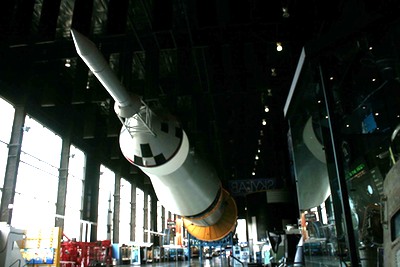Futures lostby Dwayne Day
|
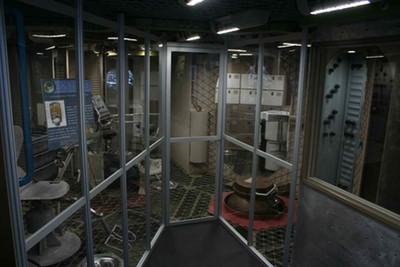 Inside the Skylab training mockup. (credit: D. Day) |
In many ways Skylab is a forgotten chapter in the American space program. NASA launched Skylab and three crews to conduct research on it and then abandoned it by 1974, allowing it to fall to Earth in 1979. NASA referred to Skylab as the “orbital work shop,” or “OWS,” which was an odd moniker at least partially due to political expediency, because NASA also wanted to build a space station, and did not want politicians to think that Skylab was a space station. They wanted something more capable. Skylab, therefore, was designed to be limited, and temporary, even though it could have easily been designed for expansion, resupply, and a much longer lifetime.
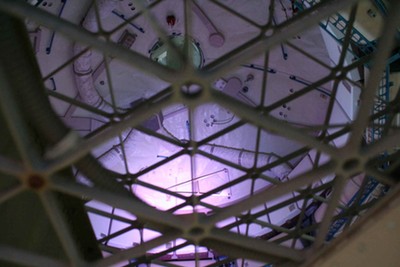 Looking up inside the Skylab training mockup. (credit: D. Day) |
NASA built a backup Skylab space station and briefly explored the possibility of launching it into orbit. But the cost of doing so was relatively high and did not fit into the overall policy of developing the new and presumably much cheaper Space Shuttle capability. The Skylab backup space station ended up in the Smithsonian National Air and Space Museum, where somewhat bewildered tourists have been walking through it for almost four decades now, often confused about what they are seeing.
There was also a substantial amount of additional Skylab hardware sitting around at the end of the program, mostly forgotten. But it too is finally getting the attention it deserves. During the past year the U.S. Space and Rocket Center in Huntsville, Alabama, has placed on display one of the Skylab training mockups inside the museum’s impressive Davidson Space Exploration Center.
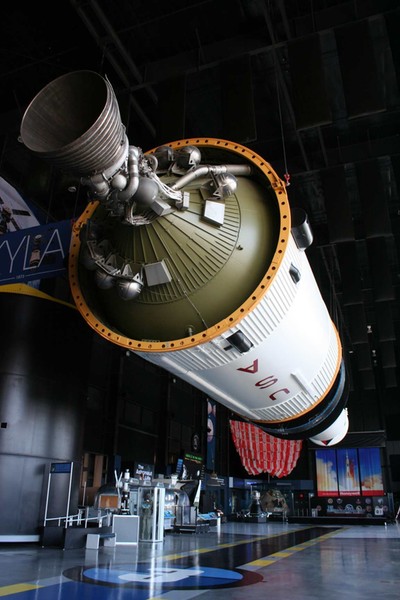 The entrance to the Skylab exhibit at the museum, to the left of the Saturn V third stage. (credit: D. Day) |
The museum’s flagship attraction is its Saturn V vehicle that for decades was displayed outside, but has been partially restored and since 2008 has been housed indoors. The museum did not simply throw up a minimal, barn-like structure around the rocket, unlike Houston, but has been steadily adding displays that tell the history of rocket engine and other development at the nearby Marshall Space Flight Center. Although not quite as big or flashy as the Apollo Saturn V Center at the Kennedy Space Center in Florida, the Davidson displays are more focused on the engineering challenges and accomplishments associated with building the big rocket and provide a great introductory history lesson to the Saturn’s development.
The Skylab training mockup has been added to the building, alongside the Saturn second and third stages. It stands vertically, in contrast to the horizontal Saturn alongside it. If there is one drawback to the display it is that the mockup’s exterior is painted black, just like the wall behind it, making it possible to walk past without noticing the entrance. In fact, during a recent visit I walked all the way to the front of the rocket without noticing the Skylab until I turned around and started back. There is a big sign saying “Skylab,” but it almost seems camouflaged in its current location and paint scheme.
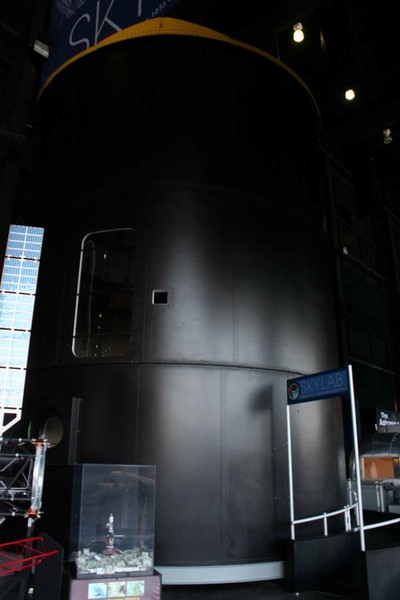 Another view of the Skylab exhibit. (credit: D. Day) |
The mockup is not the full Skylab structure, unlike the actual backup flight hardware in Washington. It includes the living deck and also the upper ring where the astronauts amusingly ran around its interior in zero gee, before tumbling out of control and breaking their necks (or maybe I’m misremembering that last part.) Visitors can walk partway into the living deck. The interior looks great and is protected by Plexiglas. One downside to displaying it this way is that it is difficult to get a true sense of the size of the interior of the workshop. But the same is true for the Skylab backup workshop on display in the National Air and Space Museum. I’ve seen tourists walk through it without once glancing up to see all the room above their heads. The Huntsville Skylab trainer currently has minimal displays and signs, but other parts of the museum have excellent signage, so presumably the museum will eventually add better displays to this artifact as well.
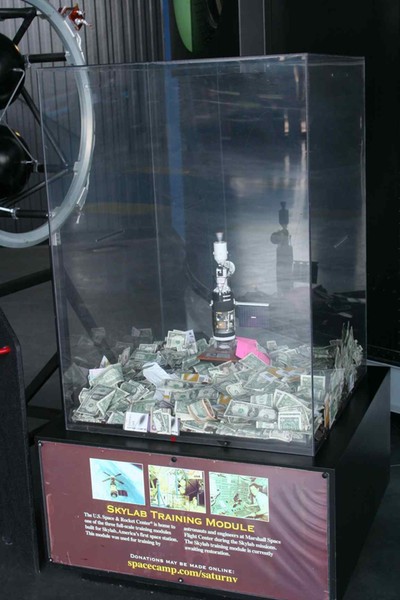 The museum is accepting donations for additional restoration work. (credit: D. Day) |
Outside the building, over in a field, are several other pieces of the mockup. These include two rings as well as the docking mount. The museum is accepting donations for further restoration work (I dropped $5 in the bin.) You can donate here. Presumably they intend to restore and include these sections (an email to the museum querying about their future plans went unreturned). If that is the plan, how will these additional sections be displayed? Will a fully restored Skylab training mockup be on a mounted platform like in the National Air and Space Museum with access from a raised deck? Or will the docking mount be laid out horizontally, alongside the main artifact?
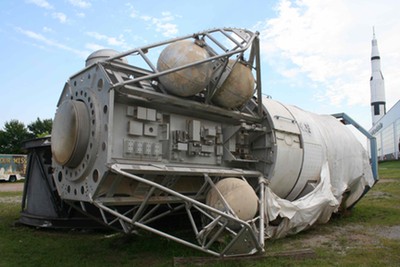  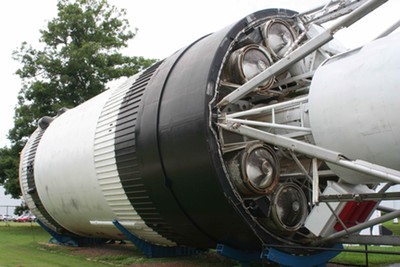 Another Skylab mockup outside the Davidson Center. (credit: D. Day) |
Outside, behind the Davidson Center, is another Skylab mockup. This is the Skylab underwater trainer that astronauts used to train for EVAs on the exterior of the workshop. Sadly, this artifact could use some work. At the very least, it requires a new coat of paint and some cosmetic repairs. In another section of the museum, near the location where Space Campers train, is a piece of the original Skylab, a charred oxygen tank recovered in Australia. It resembles the tanks that are clearly visible on the underwater trainer. If money was not an object, perhaps the ideal solution would be to add another wing to the Davidson Center and move the underwater mockup indoors along with the training mockup and the recovered oxygen tank as part of a separate exhibit on Skylab. Skylab was an impressive but mostly forgotten achievement for NASA, and it would be great to see it finally get the attention it deserves, showing what was, and what it could have been, if history had only played out differently.
